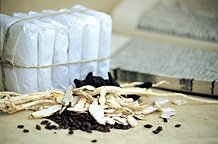The comment period for a set of U.S. Food and Drug Administration (FDA) draft guidelines to regulate complementary and alternative medicines will come to an end on May 29, 2007.
As currently written, the guidelines make two fundamental points:
"First, depending on the CAM therapy or practice, a product used in a CAM therapy or practice may be subject to regulation as a biological product, cosmetic, drug, device, or food (including food additives and dietary supplements) under the Act or the PHS Act. ... Second, neither the Act nor the PHS Act exempts CAM products from regulation."
The heart of the controversy over the guidelines stems from what could be considered the intended use of the product in question. For example:
"[A] botanical product intended for use in treating a disease would generally be regulated as a drug; a botanical product taken by mouth, labeled as a dietary supplement, and intended for use to affect the structure or function of the body would generally be regulated as a dietary supplement; a raw or dried botanical intended for use as an ingredient to flavor food would generally be regulated as a food or as a food additive, depending on whether the botanical was generally recognized as safe for its intended use in food; and a lotion containing botanical ingredients and intended for use in moisturizing the skin would generally be regulated as a cosmetic."
 To put it in simpler terms: if an herb is marketed to promote "general health and wellness," it would be subject to FDA regulations that apply to food or food additives. However, if it is marketed as part of a treatment regimen for a specific disease (such as colon cancer), it then becomes subject to FDA regulations that apply to drugs.
To put it in simpler terms: if an herb is marketed to promote "general health and wellness," it would be subject to FDA regulations that apply to food or food additives. However, if it is marketed as part of a treatment regimen for a specific disease (such as colon cancer), it then becomes subject to FDA regulations that apply to drugs.
Roy Upton, vice-president of the American Herbalists Guild and executive director of the American Herbal Pharmacopoeia, explained to Acupuncture Today, "[The] FDA has not changed their policies regarding their interpretation of drug regulations for decades. According to the FDA's interpretation of the Food, Drug, and Cosmetic Act (FDCA) they consider any substance that is intended to be used for the treatment or prevention of disease is a drug, regardless of whether the substance is a food, herb, nutrient, or pharmaceutical. This has always been their contention and the guidance document simply articulates this by saying that if CAM practitioners utilize anything within the FDA's regulatory domain (foods, drugs, cosmetics, medical devices, dietary supplements) for the prevention or treatment of disease, then that substance is a drug and that the CAM practitioner may be in violation of the Food, Drug, and Cosmetic Act if they prescribe such a substance for medicinal purposes.."
The guideline also outlines regulations regarding the use of acupuncture needles:
"To illustrate how a CAM product might be a 'device' under the Act, acupuncture is a CAM therapy that seeks to stimulate energy pathways ('meridians') by puncturing, pressing, heating, using electrical current, or using herbal medicines. Fine needles are often used, and these acupuncture needles are 'devices' under section 201(h) of the Act because they are intended for use in the cure, mitigation, treatment, or prevention of disease in man or are intended to affect the structure or function of the body of man. We regulate acupuncture needles (see 21 CFR 880.5580), but not the practice of acupuncture itself."
 FDA regulations for drugs become particularly problematic in regard to CAM products such as herbs, because the product could be considered subject to "new drug" regulations "unless it is generally recognized, among experts qualified by scientific training and experience to evaluate the safety and effectiveness of drugs, as safe and effective for use under the conditions prescribed, recommended, or suggested in the labeling. 'New drug' status triggers the Act's requirements for premarket review and approval by FDA."
FDA regulations for drugs become particularly problematic in regard to CAM products such as herbs, because the product could be considered subject to "new drug" regulations "unless it is generally recognized, among experts qualified by scientific training and experience to evaluate the safety and effectiveness of drugs, as safe and effective for use under the conditions prescribed, recommended, or suggested in the labeling. 'New drug' status triggers the Act's requirements for premarket review and approval by FDA."
Upton noted, however, that this has no force of law behind it. "In a nutshell, the FDA Guidance Document on CAM products is the FDA's articulation of how products used by CAM practitioners may be regulated. It has no authority of law and is simply as stated, a Guidance Document. It is a valuable document, as to my knowledge, it is the first formal articulation by the FDA of how they interpret current food and drug law in relationship to CAM practitioners. However, it divulges nothing new, offers no new policies, and will stimulate no new regulation, nor will it restrict access to anything at any time. Such restrictions can only happen if Congress chooses to reopen and modify the Dietary Supplement Health And Education Act (DSHEA), which is always possible, but would create a fervor that you would not believe."
Despite the hue and cry from certain segments of the CAM community, Upton went on to explain. "In my observations, many practitioners believe they are exempt from FDA authority because the FDA has no direct authority over 'practice' issues and because the FDA's authority generally only extends to products in interstate commerce. Neither assertion is entirely true. The FDA maintains regulatory authority over the sale of any food, drug, cosmetic or supplement that contains ingredients that were in interstate commerce (e.g. alcohol for making tinctures, packaging material, herbs purchased from out of state and then dispensed regionally, etc.)."
The American Association of Acupuncture and Oriental Medicine (AAAOM) also issued an official statement on its Web site, which reads:
"The FDA has written a document entitled 'Guidance for Industry on Complementary and Alternative Medicine Products and Their Regulation by the FDA.' This draft guidance seeks to clarify when a CAM product is subject to regulation under the Federal Food, Drug, and Cosmetic Act (called 'the Act') or the Public Health Service Act (called the 'PHS Act').
The AAAOM has asked several of our expert analysts to review this draft guidance. Based on these reviews, our conclusion is that this document simply reiterates the current regulatory status of CAM products, including herbs. This document contains no new proposed regulations or principles. We see no language that attempts to redefine herbs as drugs or that proposes any new regulation of herbal medicine.2
The AAAOM has sent a letter to the FDA acknowledging the draft guidance and alerting them to our desire to be present for any future discussions regarding CAM products. The AAAOM will continue to monitor FDA actions that could impact the practice of acupuncture and Oriental medicine. We encourage our members to read this document and share any concerns with the AAAOM."
Regardless of whether these new regulations represent a foot in the door for Oriental medicine to gain true legitimacy, or a crackdown on the profession and the entire non-allopathic health care industry, there is little that can be done until the FDA sifts through all of the comments and issues a final guideline.
References
- Guidance for Industry on Complementary and Alternative Medicine Products and Their Regulation by the Food and Drug Administration. Draft Guidance issued by the U.S. Department of Health and Human Services, Food and Drug Administration, December 2006. Available at: www.fda.gov/cber/gdlns/altmed.pdf.
- AAAOM Position on the FDA Draft Guidance for CAM Products. Available at: www.aaaomonline.org.



